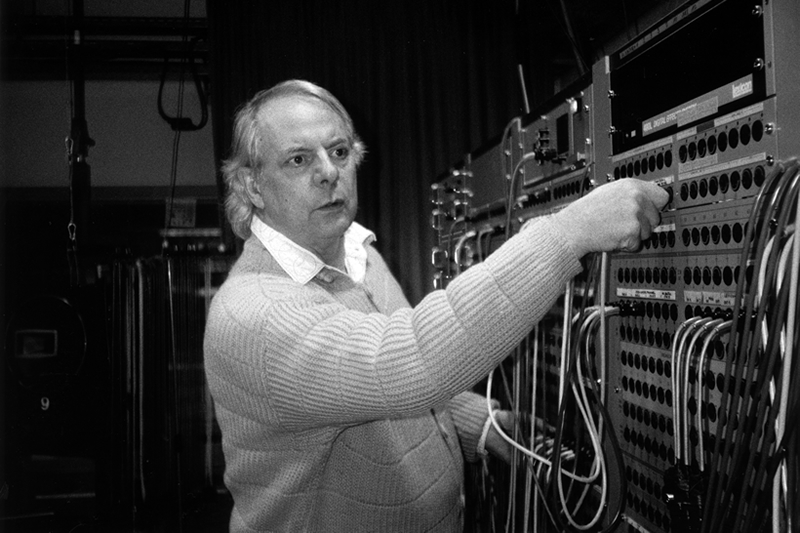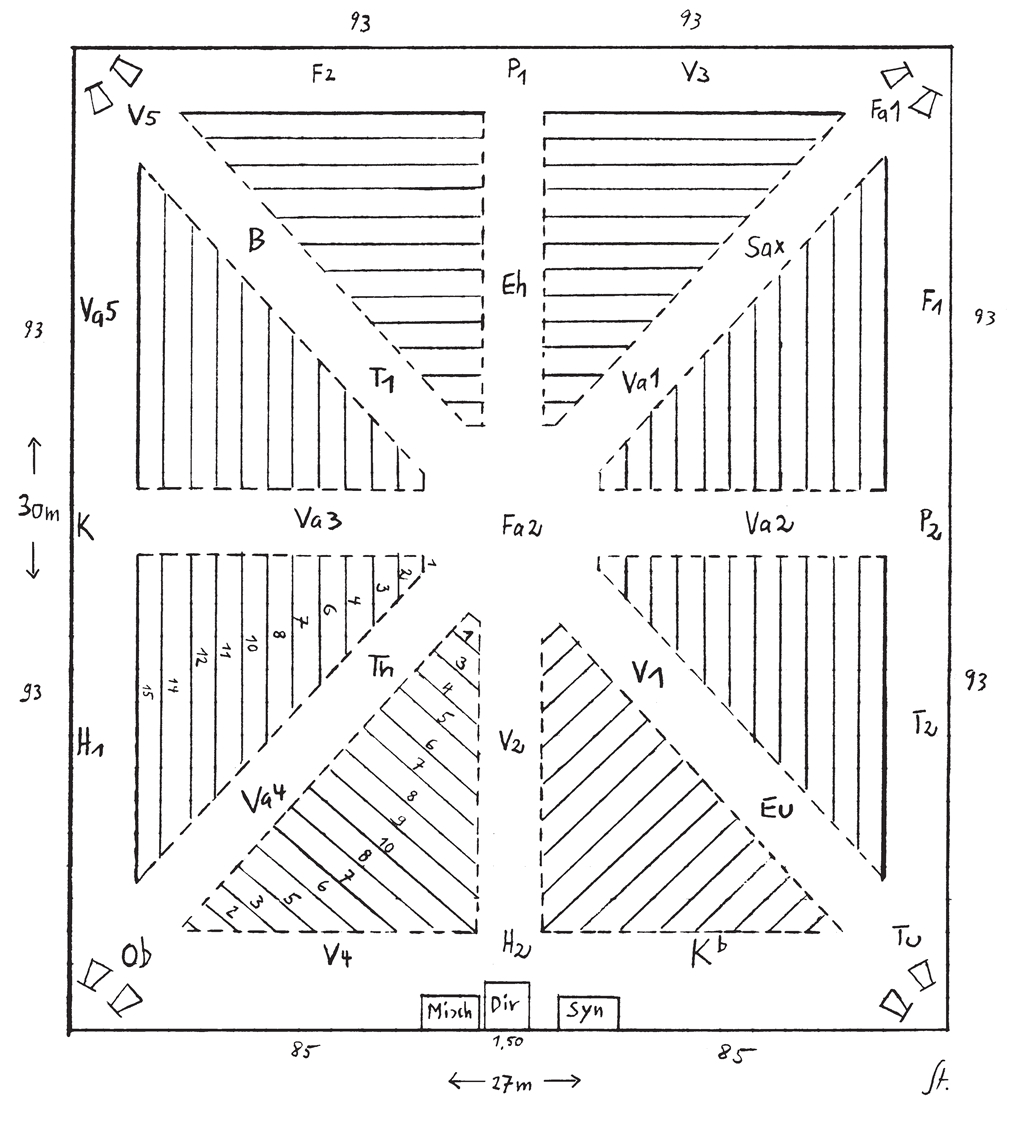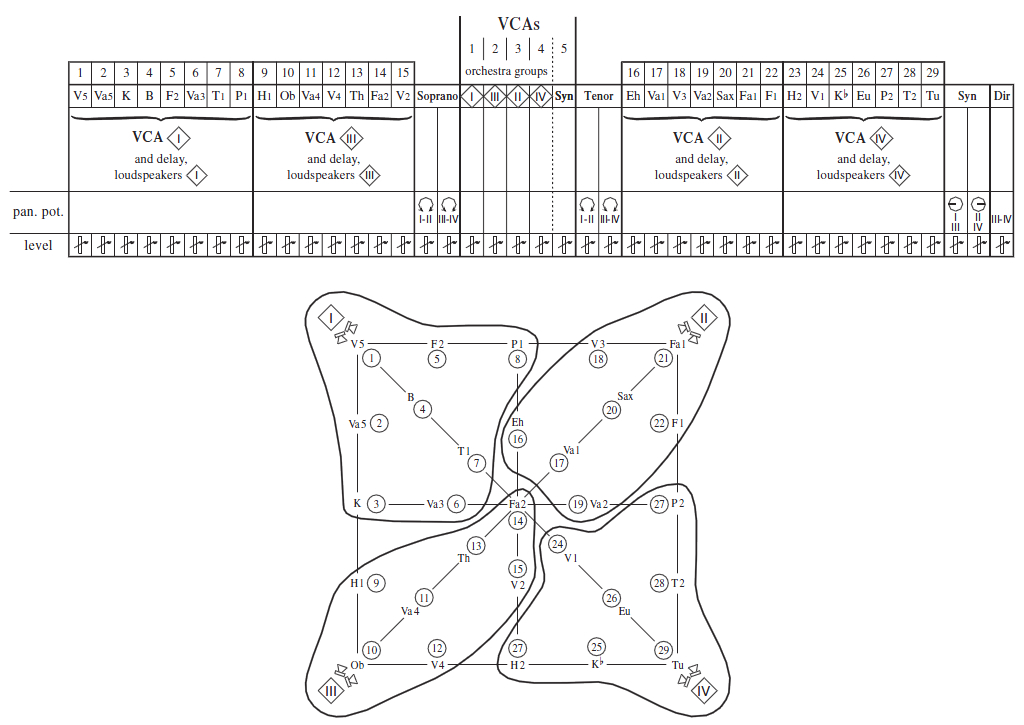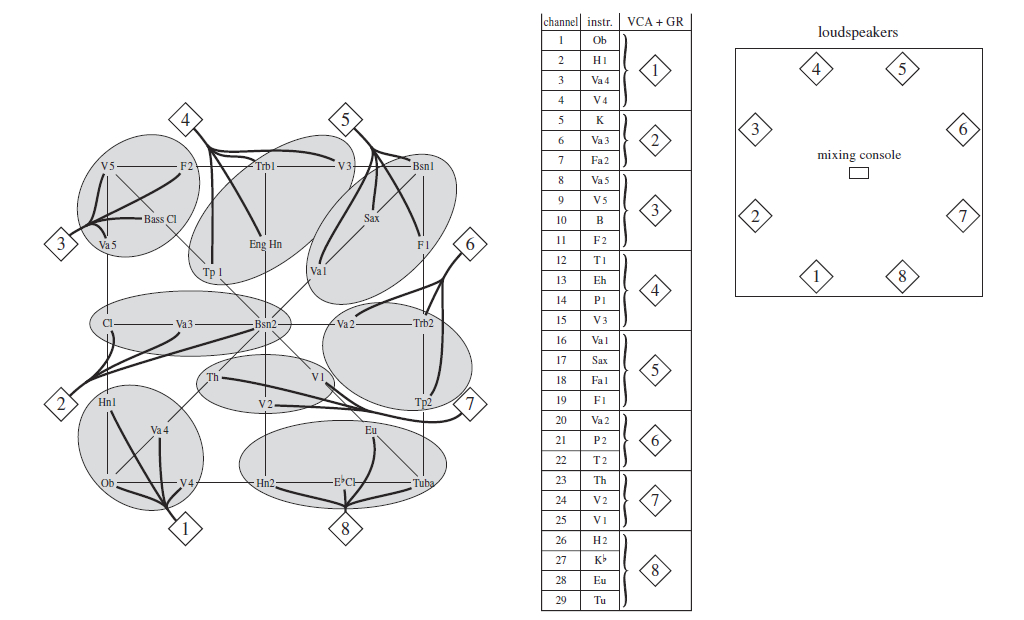
Instrumentation Works for Orchestra
Stockhausen Complete Edition on CD
Since 1991, a complete edition of all recordings in which Karlheinz Stockhausen has personally participated is being released on compact discs. Each CD in this series is identified by Stockhausen's signature followed by an encircled number. The numbers indicate the general historical order of the works.
Stockhausen realised the electronic music and participated in these recordings as conductor, performer, sound projectionist, and musical director. He personally mixed down the recordings, mastered them for CDs, wrote the texts and drew the covers.
- The compact discs may be obtained from the Stockhausen-Verlag: Kettenberg 15, 51515 Kuerten, Germany (www.stockhausenCDs.com).
Karlheinz Stockhausen
Instrumentation Works for Orchestra
LIGHTS – WATERS
Introduction
LIGHTS – WATERS
for soprano, tenor and orchestra with synthesizer
(duration circa 52 minutes)
is the GREETING of SUNDAY from LIGHT. It was composed 1998–1999,
commissioned by the Southwest German Radio (SWR) for the Donaueschingen Music Days.
The world première of LIGHTS – WATERS took place on October 16th 1999 at the Baar gymnasium in Donaueschingen, and a second performance was given there on Sunday, October 17th. The performers were Barbara van
den Boom (soprano), Hubert Mayer (tenor), Antonio Pérez Abellán (synthesizer) and the SWR Symphony Orchestra Baden-Baden / Freiburg conducted by me. The sound equipment was operated by Michael Acker (sound projection) and André Richard of the Experimental Studio of the Heinrich Strobel Foundation in Freiburg.
Since 1977, I have been composing the work LIGHT, The Seven Days of the
Week, using a super formula, which comprises three synchronous formulas.
In LIGHTS –WATERS, 17 blue lamps stand next to 17 instruments of the higher register. They correspond to the 17 notes of the MICHAEL
formula. 12 green lamps, next to the lower instruments, correspond to the 12
notes of the EVE formula. The lights are lit in succession with the entries of the individual instruments. Near the end, the instruments stop playing one
after another for a moment, each player takes a sip of water and then leaves, playing sustained notes.
Form
The Anfangs-Duett (Initial Duet) of soprano and tenor is followed by the Eingang (Entrance) of the instruments.
12 MICHAEL waves and 12 EVE waves begin synchronously, separate polyphonically and meet at 7 further synchronous beginnings, connected by 6 bridges.
The Ausgang (Exit) of the instruments begins at bar 692 and is followed by the Schluss-Duett (Final Duet).
In the 12 waves, the durations of the two formulas are gradually enlivened,
from undivided durations of the formula notes in the first wave to maximally
subdivided durations in the 12th wave: 17 durations per in the 12th M
wave, 12 durations per
in the 12th M
wave, 12 durations per in the 12th E wave.
in the 12th E wave.
Spatial Composition
The individual notes of both formulas move from instrument to instrument in two spatial layers. The positions of the instruments can be seen in the following sketch. The musicians play standing facing the conductor, who stands with his back to one of the walls (Dir.).
Each musician has 2 music stands: one for the music and a second one, with the rack positioned horizontally, for lamp and glass of water.
The spatial positions and movements of the singers are notated in the score.
The audience is seated in 8 triangles facing the centre.
Texts
The rotations of the notes in space are related to the rotations of the 9 planets and 61 moons of our solar system, whose names, astronomical characteristics and significances are sung. The sung texts were written by me and are printed on pages XXXVII –XLIII of this score.
| F1, F2 | = | flutes |
| Ob | = | oboe |
| Eh | = | English horn |
 |
= | E-flat clarinet |
| K | = | clarinet |
| B | = | bass clarinet |
| Fa 1, 2 | = | bassoons |
| Sax | = | baritone saxophone |
| H 1, 2 | = | horns |
| T 1, 2 | = | trumpets |
| Th | = | tenor horn |
| Eu | = | euphonium |
| P 1, 2 | = | trombones |
| Tu | = | tuba |
| V 1–5 | = | violins |
| Va 1–5 | = | violas |
| Misch | = | mixing console |
| Dir | = | conductor |
| Syn | = | synthesizer |
The floor area of the Baar gymnasium in Donaueschingen measures 27 x 30 m.
The chairs were placed as indicated in the drawing on the right, with aisles 2 m wide (circa 3 m wide in front of the conductor). 6 of the triangles could each contain 93 chairs, the 2 triangles next to the conductor had 85 chairs each, adding up to a total of 728 seats.
The public entered at the right. The soloists, conductor and half the musicians entered from dressing rooms on the left.
The balcony, on which twelve of the orchestra musicians played the 4th Bridge,
was located at the right above the doors through which the audience entered.

Synthesizer and mixing console stand on the floor.
Performance Practice
Orchestra Parts
There are 29 orchestra parts.
Most of the time, individual notes pass from instrument to instrument;
therefore, starting at bar 87, each of the 29 parts comprises the score (without the synthesizer part), to enable each musician to insert his individual notes into the context, thus contributing to the continuity of the spatial melodies. That is why each instrumentalist should follow the parts of the others and insert his tones organically, especially in regard to the durations and dynamic levels.
In the parts, the orchestra is divided into two groups of staves, one for the 17 higher instruments and one for the 12 lower in struments. Between them is a staff for the instrument concerned. Therefore, every note in that staff also appears in either the upper or lower groups of staves. For every section, the upper and lower part is rehearsed separately. Therefore each player must mark the notes in his staff which be long to the upper part and those which be long to the lower part.
The pitches in the orchestra staves are notated as sounding; for transposing instruments, the fingered pitches are written in the staff of that instrument (see Notation).
Sectional rehearsals for the upper and lower parts are not recommended, because this differentiation is not consistent in the individual parts. All of the noises and the microtonal pitches should, however, be prepared in individual rehearsals.
In addition to these 29 parts, each of the 12 musicians who play on the balcony from bars 461 to 519 receives his part on an additional sheet of music. For this moment, 12 music racks stand on the balcony. The balcony should be at the upper right, as seen by the conductor. If there is no balcony, then a high podium must be built at the right wall (as seen by the conductor) for the 12 musicians.
If the orchestra does not play the end from memory, 29 small pages of music are used when the musicians exit after taking a drink of water. These may be fastened to the forearm or to the instrument.
For the two singers there are special reduced parts which can be held in one hand during the rehearsals and possibly also during the performance.
The synthesizer player plays from the score.
Choice of the instrumentalists
The numeration of the instruments (F 1 - F 2 etc.) does not indicate various
musical-technical demands on the individual players; on the contrary, all
are equally important (also violins 1–5 and violas 1–5).
The customary division of register between the two horn parts is not made; both parts are high and low.
Bassoon 2 plays often because of its central spatial position.
Both trombones need an F-attachment.
Course of a performance
Entrance
There should be dressing rooms at the left and right of the hall for the musicians (as seen by the conductor).
The orchestra tunes there before the beginning.
In a concert performance, during the fermata following bar 13 , the 17 musicians of the higher group quickly but calmly enter the hall from the left and position themselves at the wall next to each other.
As indicated in the score, they successively enter the hall in the order
F 2 - V 5 - K - Ob - V 4 -  - T 2 - F 1 - V 3 - Eh - T 1 -
- T 2 - F 1 - V 3 - Eh - T 1 -
Va 3 - Th - V 2 - V 1 - Va 2 - Va 1
arriving at their places just before beginning to play ( F 2 already at the end
of the fermata in bar 13, V 5 in bar 15, etc.).
The soprano shows each one to his place and either personally lights the musician's blue lamp before he begins to play (see the instruments with * above the soprano staff), or she gives a sign to the musician to light the lamp himself. Exception: before bar 62, she also lights the green lamp in the middle of the hall for bassoon 2.
At the same time, during the fermata of bar 13, the 12 musicians of the lower group enter the hall from the right and position themselves at the wall next to each other. As indicated in the score, they walk in the order
Tu - P 2 - Fa 1 - Sax - P 1 - B - Va 5 - H 1 - Va 4 - H 2 - Fa 2 - Eu
arriving at their places just before each begins to play (Tu already at the end of the fermata in bar 13, P 2 in bar 15 etc.).
The tenor shows each one to his place and either personally lights the musician's green lamp before the musician begins to play (see instruments with * above the tenor staff), or he gives a sign to the musician to light the lamp himself.
The soprano and tenor, as well as the 14 players who light their own lamps, need suitable lighters (see photograph 2 on page X).
The following list indicates the players who light their own lamps (SELF) and how many bars of rest each has to count (starting at bar 14) before his entry. L = enter from the left, R = enter from the right.
| light | instrument | bars of rest starting at bar 14 |
bar of entry | ||
| L | blue | flute 2 | 0 | 14 | |
| R | green | tuba | 0 | 14 | |
| L | blue | violin 5 | 2 | 16 | |
| R | green | SELF | trombone 2 | 2½ | 16 |
| L | blue | SELF | clarinet | 3 | 17 |
| L | blue | oboe | 10 | 24 | |
| R | green | bassoon 1 | 10 | 24 | |
| L | blue | violin 4 | 11½ | 25 | |
| R | green | SELF | saxophone | 14 | 28 |
| R | green | trombone 1 | 14½ | 28 | |
| R | green | SELF | bass clarinet | 15½ | 29 |
| L | blue |  clarinet clarinet |
18 | 32 | |
| R | green | viola 5 | 18 | 32 | |
| L | blue | SELF | trumpet 2 | 21 | 35 |
| L | blue | SELF | flute 1 | 23 | 37 |
| L | blue | SELF | violin 3 | 24 | 38 |
| R | green | horn 1 | 28 | 42 | |
| L | blue | English horn | 34 | 48 | |
| R | green | SELF | viola 4 | 34 | 48 |
| R | green | horn 2 | 42 | 56 | |
| L | blue | SELF | trumpet 1 | 48 | 62 |
| R | green | bassoon 2 | 48 | 62 | |
| L | blue | SELF | viola 3 | 52 | 66 |
| L | blue | SELF | tenor horn | 54 | 68 |
| L | blue | violin 2 | 60 | 74 | |
| R | green | euphonium | 60 | 74 | |
| L | blue | SELF | violin 1 | 61 | 75 |
| L | blue | SELF | viola 2 | 63 | 77 |
| L | blue | SELF | viola 1 | 64 | 78 |
It is important that each player knows how many bars of rest he has before his entry and walks in such a way that he can see the conductor.
During the Entrance, all INDividually and IRRegularly play sustained isolated notes, separated by pauses of various lengths. Following the Entrance, the 1st Wave begins at bar 87.
4th Bridge
Starting at bar 448, 12 musicians go onto the balcony and position themselves next to each other at the balustrade in the order:
selves next to each other at the bal us trade in the order:
P 1 - Eh | Th - Fa 2 | Eu - Tu || T 1 - K | F 1 - T 2 | Ob -  .
.
Starting at bar 517 all of them quickly go back down into the hall and at 530 play from their previous positions.
Exit
Starting at bar 692, each musician irregularly and slowly plays sustained individual notes of various durations, separated by pauses of different lengths (similar to bar 14 ff).
During the rests where trinken(drink) is indicated, the soprano or tenor offers the musician his glass of water, or indicates that he should drink. Each takes a drink and then walks out to the right (as seen by the conductor), playing.
The tenor gives flute 2 and violin 3 their glasses of water and the soprano gives violin 4 and tuba their glasses of water. Every one else – at signs given by the singers – picks up his own glass and takes a drink.
After all the musicians are outside and are no longer playing, the soprano and tenor sing the Final Duet in the middle of the hall. Starting at bar 737, with the soprano in the lead, they walk towards the conductor, singing, and then out to his left.
The conductor receives the applause, waving the two singers to join him on the conductor's podium. After this, he thanks the synthesizer player and the sound projectionist. Meanwhile, the orchestra enters and lines up side by side in front of the conductor's podium, filling the entire breadth of the hall. The conductor thanks the orchestra. He and the singers leave and re-enter from the left several times, the orchestra remains standing until the applause has ended.
Rehearsals
To prepare for the world première I had two rehearsal periods of 2 days each with the singers ahead of time. Then, twelve rehearsals of 4 hours each (in the fore noon) with singers, or chestra, synthesizer and the complete sound equipment in the correct set-up (with reduced dimensions) took place at the Rosbaud Studio of the SWR in Baden-Baden. Every afternoon, there was a rehearsal with the singers, synthesizer player, conductor and sound projectionist.
At the performance venue in Donaueschingen, it took a day to in stall the lighting and sound equipment. The forenoon of the next day there was a rehearsal with the singers. This was followed by 6 tutti rehearsals (forenoons and afternoons), including the dress rehearsal in the forenoon preceding the world première.
Actually, another week of rehearsals would be necessary to perfectly implement the dynamic and rapid rhythmic succession as required by the score.
For rehearsing the singers' parts, a recording of the orchestra and the synchronous synthesizer part (two 8-track tapes) and a rehearsal compact disc of the orchestra recording (with up beat pulses following indeterminate fermatas) may be ordered from the Stockhausen-Verlag.
Sound Equipment
The instruments are slightly amplified using 29 microphones, mixing console with sound projectionist, 4 delay units, and 4 x 2 loudspeakers high up in the four corners of the hall. In doing so, the amplified sound of each instrument should be localised where it is being played.
Soprano and tenor are amplified using transmitters.
The mixing console allocation is, for example:
The 29 signals of the instruments are distributed into four groups (I - II - III - IV), which are projected relatively softly over the four groups of loudspeakers:
In order for the instruments to be heard from the place where they are standing, the 4 groups are delayed by ± 20 milliseconds. The optimal length of delay must be ascertained during the rehearsals.
In very dry acoustics, the 4 groups may be slightly reverberated using four reverberation units.
Soprano and tenor are circuited to groups I–II and III–IV using two faders each.
The sound projectionist follows their movements in space using faders I–II for the
movements at the rear and III –IV for the movements at the front, while using the panorama potentiometers for the left-right movements.
2 quadrophonic joysticks with only 2 faders for the dynamic levels would have
been more suitable for continuously following the singers.
The two channels of the synthesizer were separated: all M (MICHAEL) notes should be projected quasi parallel with the movements of the tenor, all E (EVE) notes with the movements of the soprano (see above).
The conductor needs a microphone for all the rehearsals. His voice is projected over loudspeakers III–IV and two small loudspeakers about midway at the sides of the hall.
The sound projectionist with complete sound equipment should participate in all rehearsals.
The dimensions of the rehearsal hall must correspond approximately to those of the performance hall.

Lighting
In the rehearsal hall, the places where the musicians stand, the aisles for the soloists, the mixing console, synthesizer and the conductor must be sufficiently lit. In the concert hall, at least 29 x 2 spotlights from above should be aimed at the music racks and the instrumentalists. Additional spotlights must light the middle of the hall, the aisles and the balcony (only during bars 447 - 529). The conductor must be especially brightly lit from above and a black curtain should be hung behind him. It is best for him to be dressed in white.
For the world première, traverses for the spotlights were hung at the ceiling of the gymnasium above all of the aisles. For lighting corrections, a lighting technician was present at all rehearsals.
Recording and mixdown
Following the world premiere, I conducted the SWR Symphony Orchestra Baden-Baden / Freiburg in a studio recording (Hans Rosbaud Studio) of LIGHTS - WATERS from October 25th to October 30th 1999. This recording was made without singers and synthesizer. The positions of the musicians were the same as during the rehearsals and performances. The 29 instruments were recorded on 29 tracks. Every afternoon (the recording sessions were forenoons only), we selected the best takes. The collaborators were: Bemhard Mangold (recording supervision), Frank Wild (sound engineer), Klaus-Dieter Hesse (multi-track editing).
From November lst through 13th, with the same collaborators, the 29-track recording was first edited, and then mixed down by me to an 8-track version. This took place in control room II of the SWR radio play studio in Baden-Baden. We heard the 29 tracks in eight groups over eight loudspeakers set up in a circle (see drawing at the right).
The singers were subsequently recorded from January 17th to 21st 2000.
Wearing earphones, over which I could hear the 8-track recording of the orchestra, I conducted the singers. After this, the synthesizer was synchronised into the recording.
From March 6th to March 18th 2000, with the above mentioned collaborators, I made the stereo mix-down of the multi-track recording in control room II of the SWR radio play studio in Baden-Baden.
This result was released by the Stockhausen-Verlag on compact disc 58.
Lists of all the movements of the soprano, tenor, MICHAEL and EVE notes of the synthesizer in the stereophonic sound panorama are in the archives of the Stockhausen Foundation for Music.
Quasi concert performance without orchestra
In a staged performance of SUNDAY from LIGHT, LIGHTS – WATERS as as the SUNDAY GREETING must be performed with orchestra in a suitable hall on the day of (or the day preceding) the performance. The arrangement of the instrumentalists and placement of the audience, the ritualistic performance practice with lights and waters, and the sound equipment already described are inalterable requirements.
If — for a quasi concert performance of the work — an orchestra is not available, it is possible to perform LIGHTS — WATERS with soprano, tenor, synthesizer, and 8-track playback of the orchestra. The hall, seating of the audience, sound projection of the singers and of the synthesizer should be identical to that already described.
The 29-track recording of the orchestra was mixed down to an 8-track version (= 8 groups of instruments), which is played back over 8 or 8 x 2
loudspeakers  to
to  , surrounding the audience. Its dynamic level is balanced with that of the singers and the synthesizer by a sound projectionist seated at a mixing console in the middle of the hall.
, surrounding the audience. Its dynamic level is balanced with that of the singers and the synthesizer by a sound projectionist seated at a mixing console in the middle of the hall.
In this version, the synthesizer plays live only in the Initial Duet (until bar l4), during the First Announcement (bars 448-461), the Second Announcement (bars 484-493), the Third Announcement (bars 517-530) and in the Final Duet (bars 728—end).
Using a second 8-track tape machine (tracks 5-8), all of the other sections of his part are played back synchronous to the 8-track tape of the orchestra over the same 8 loudspeakers or groups of loudspeakers: tracks 5 and 7 on loudspeakers
1 - 2 - 3 - 4, tracks 6 and 8 on loudspeakers 5 - 6- 7 - 8 (see drawing).
The entries for the singers after fermatas and entrances for the singers and sound projectionist (to start both 8-track machines following the three Announcements) could be given by the synthesizer player.

The two 8-track tapes with orchestra and synthesizer and a description of this special performance practice may be ordered from the Stockhausen-Verlag.
When performed in this way, it is absolutely necessary to inform the audience in the programme book that the movements of the notes from instrument to instrument as compared to a performance with orchestra is greatly reduced and to a great extent annulled.
For study purposes there are also two 8-track tapes with soprano, tenor, orchestra and synthesizer in the archives (see end of page XXXV).